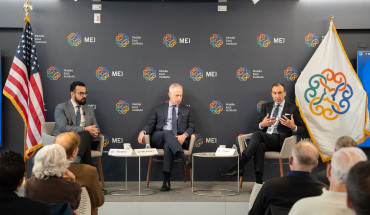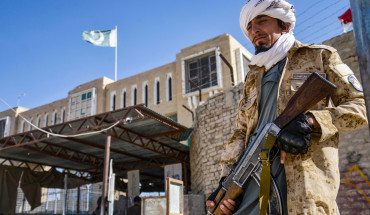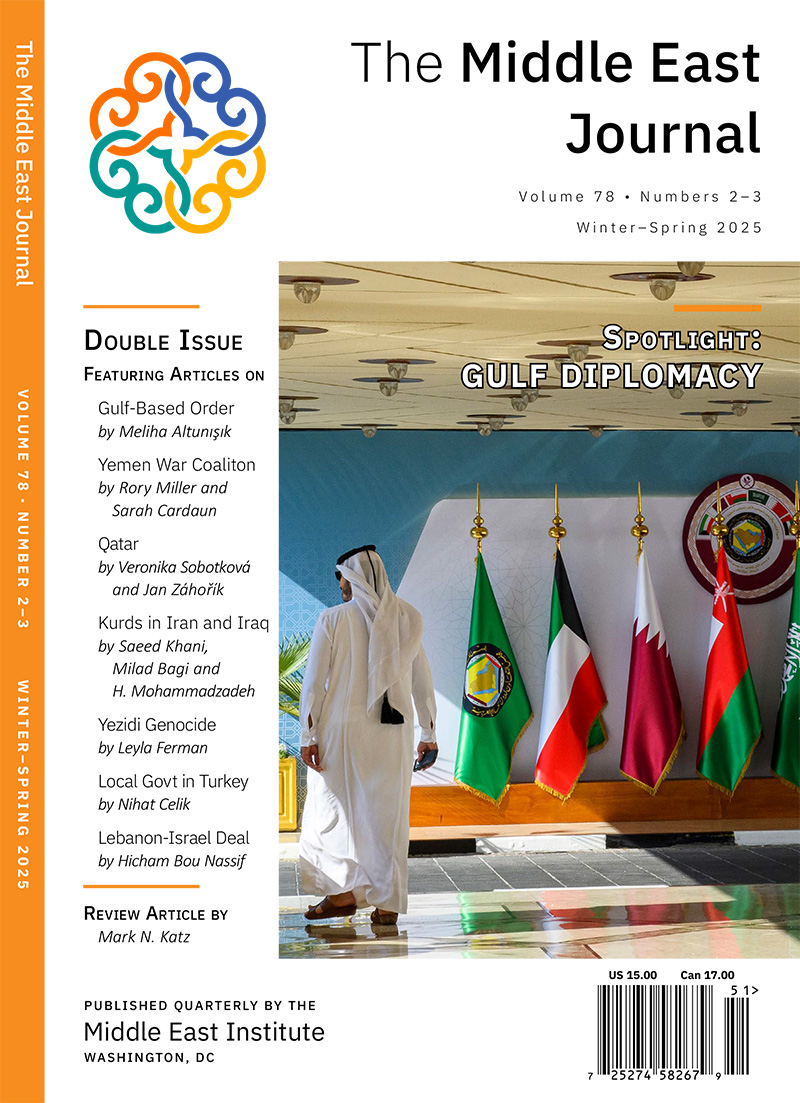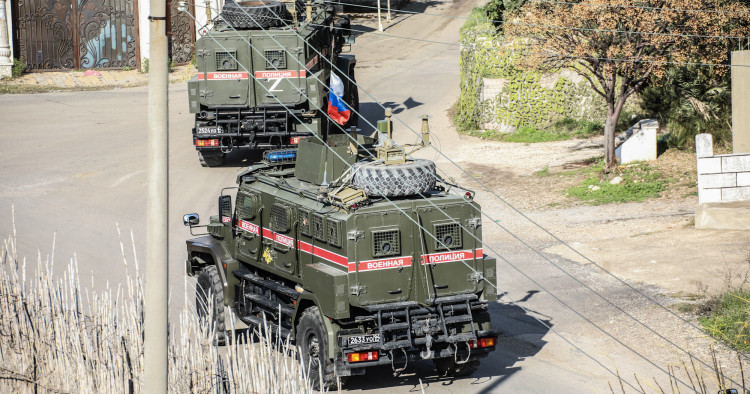Due to the peculiarities of Russia’s system of government, its authorities routinely demonstrate a rather notorious trait: a stubborn unwillingness to admit mistakes, while confidently claiming their own righteousness. As a result, the official list of blunders for which the Kremlin has publicly taken responsibility over the past two decades is rather short. It includes, for example, President Vladimir Putin’s admission of excessive trust in the West — trust which, he suggested, the West erroneously perceived as coming from a position of weakness on the part of Russia — the mistake of concluding the 2014/15 Minsk cease-fire agreements with Ukraine, and the problems associated with the Russian military’s mobilization in 2022.
As such, it is not surprising that the Kremlin categorically refuses to call the fall of the regime of Bashar al-Assad a “defeat” for Russia, instead referring to purportedly having achieved its counterterrorism “goals” in Syria. Furthermore, the Kremlin is trying to suggest that the uncertainty surrounding the continued operation of the Russian air and naval bases in Khmeimim and Tartous is the result of Moscow’s deliberate decision to pause and reconsider the advisability of maintaining its military presence in Syria — even though numerous regional actors are supposedly requesting that the Russians stay.
The theater around Russian-Syrian negotiations
This public feigning of calm is not only due to an obvious need to save face on the global stage and domestically. It is also a cover for the ongoing postmortem in the Russian corridors of power to determine who among the security forces is to blame for “losing” Syria and what urgent anti-crisis measures Moscow should take now. The current strategic rethink will, in one way or another, lead to, as Fyodor Lukyanov, an analyst close to the Kremlin, put it, “a rebalancing of Russia’s positions in the region” and “an adjustment of relations with countries.” It is, therefore, important for regional actors and especially for the Kremlin itself to understand the limits of such Russian self-rebalancing.
Media reports about the “positive atmosphere” surrounding Russia’s negotiations with the new transitional government in Syria, and more precisely with the Hayat Tahrir al-Sham (HTS) administration, combined with foreign analysts’ conclusions about Moscow’s operational pivot from Syria to Libya, give the impression that the Kremlin is in principle successfully adapting to the changed conditions. Moreover, Russia’s proactivity on the Libyan track, as evidenced by its efforts to transfer military equipment from Khmeimim and Qamishli to Libya’s al-Khadim and al-Jufra air bases, to some extent explains the Kremlin’s self-delusional complacency, despite the risk that all of its previous efforts to cement a presence in the Middle East and build logistics corridors into Africa might come undone.
However, either maintaining Russia’s military bases in Syria or finding an alternative outpost in the Mediterranean will prove extremely difficult for Moscow. And part of the problem with pursuing the latter option, particularly if in Libya, is that it would require a full-on transformation of Russia’s military presence model — from more traditional bases designed to establish deterrence by showing the flag in the region to building up a military and logistical operation inside a security and legal “gray zone.” The associated hazards of attempting this are obvious not only for the Kremlin’s opponents but also for Moscow itself. Indeed, the pursuit of shadow activities in the region, where Russia may have had episodes of cooperation on sensitive issues with individual actors but never developed any real strategic partnerships, would require considerable effort and concentration on the part of the authorities in Moscow, which is extremely difficult to maintain over an extended period.
This is not an insignificant consideration, as the Russian foreign policy decision-making process, both vis-à-vis the region and writ large, is fragmented and can often swing toward supporting those actors with whom a particular agency or intelligence service department had established closer cooperation at a given moment. Thus, although officially the Russian Ministry of Foreign Affairs and the Ministry of Defense (MoD) have always declared close coordination on Syria policy, after 2017 the military and representatives of Russia’s special services, who had bet on Assad, actually pushed the diplomats into the background. The collapse of the Assad regime shattered the myth that the problems of Syria’s fragmentation and the armed opposition had been resolved, and it once again brought to the fore Russian diplomats interested in preserving a functioning system of checks and balances inside Syria that Moscow could take advantage of. As a result, in December 2024, they were the ones who negotiated the withdrawal of blocked units of Russian troops from dozens of outposts across Syria (often 10-15 troops with allotted equipment at each such support point). And now, diplomats are conducting the lion’s share of the conversations with the interim Syrian government on the nature of Russia’s involvement in the country’s future, including on the key question of Moscow’s military presence.
It is also important to note that the initial optimism surrounding the negotiations between Moscow and Damascus was greatly exaggerated by the media. Moreover, the new Syrian authorities may well have slightly adjusted their position compared to December 2024, after having gained some additional foreign policy experience as well as receiving numerous new promises and guarantees from regional and global players in the ensuing weeks.
In any event, contradictions began to surface following the visit of a Russian interagency delegation for talks with de facto Syrian leader Ahmed al-Sharaa in late January. The head of the Russian negotiating team, Deputy Foreign Minister Mikhail Bogdanov, issued a public statement emphasizing the “constructive tone” of the dialogue and the positive aspects of the meeting. For its part, however, the Syrian side belatedly released a late-night statement that diplomatically points to the need for Moscow to recognize “past mistakes” and “restore trust through concrete measures such as compensation, reconstruction and rehabilitation.” Sharaa was reportedly more blunt during the talks, apparently raising the topics of Assad’s extradition and the return of $2 billion worth of assets to Syria; these demands may have been meant as an initial negotiating position, indicating Damascus’ maximum demands, some of which are a priori unrealizable. Clearly, Moscow will not agree to Assad’s extradition under any conditions. This is not simply because of the Kremlin’s characteristic unwillingness to admit mistakes but rather because it would deal a serious blow to Russia’s image as a player that steadfastly supports its partners, even ones with dubious legitimacy, who seek to hold on to their unstable regimes. Russian participation in Syria’s reconstruction may be only symbolic and concern support for the operation of a number of Syrian facilities originally built by the Soviet Union; or it may only entail the supply of construction materials that Moscow promised to send back during the Assad era.
It is also clear that Damascus does not trust Moscow, as evidenced by the Syrians’ inspection of Russian military convoys. The long pause in January before the Syrian authorities again allowed Russian cargo ships to enter the port of Tartous to evacuate military equipment withdrawn from various outposts was likely also related to this sentiment. According to this author’s sources, Sharaa’s government feared that Moscow would supply weapons to former Syrian army units that periodically engaged in firefights with the HTS-linked General Security Directorate.
Russia’s bleak prospects in Syria
The main goal of the Russian negotiators’ efforts at this stage is not only to protect the country’s image in the region but also to reach an agreement so that Russia can continue to use the former military facilities in Syria as forward staging posts to support logistical operations on the African continent. However, given that the real beneficiary of the hypothetical arrangements is primarily the Africa Corps or the Wagner Group private military company (PMC), which still retains a certain degree of autonomy from the Russian MoD in the Central African Republic, it is difficult to imagine this activity as purely non-war, even if the transfer of goods is not carried out by military transport but, for example, by commercial aviation or aircraft of the Ministry of Emergency Situations.
The possibility of using Khmeimim and Tartous to demonstrate a serious threat to the North Atlantic Treaty Organization’s (NATO) “southern flank” is now out of the question, even if the outcome of the negotiations is positive for Moscow. The Syrian opposition that has come to power is interested in developing relations with the West and in lifting the numerous sanctions against the country, the maintenance of which European politicians directly link to the continued presence of Russian bases in Syria.
The haggling over the Russian bases may take on a somewhat protracted character. If Damascus decides it is profitable to continue playing the Russian card and to maintain a regional security counterbalance in the form of hosted Russian military facilities, it would be fairly reasonable for the Syrian authorities to postpone their final decision because of the need to form an appropriate negotiating team that will have to revise all bilateral agreements with Russia on a variety of issues. This applies not only to the prospect of military cooperation of any kind but also to a range of other agreements, including those concerning the status of Russian, which was introduced as a second foreign language in Syrian schools.
Moscow is likewise interested in giving the appearance of an active negotiation process, which it is now demonstrating in principle not only with statements but also by maintaining a symbolic military presence at the Qamishli air base, although the main military equipment was already withdrawn from there to Russia and Libya in December 2024.
Preserving the navy’s logistical support center in Tartous, which has been in operation since 1971, is more important to the Kremlin. Given Ankara’s continuing ban, based on its interpretation of the Montreux Convention, on the passage of warships through the Turkish Straits and the inability to rotate ships between the Black Sea Fleet and the Russian Mediterranean Sea task force, Russian sailors need a bridgehead in the Mediterranean. Since 2022, following the outbreak of the full-scale Russo-Ukrainian war, Russia has only been able to rely on vessels from its other, more distant naval fleets to carry out deterrence operations. For Moscow, sea-based combat duty in the Eastern Mediterranean is a significant element of its broader military planning because these operations — which include inter alia harassment actions, area denial, and launching vessels in the waters near Crete to counter the presence of the United States’ locally operating carrier battle group — have reduced the range from which the US Navy’s 6th Fleet could launch a hypothetical attack on the Russian homeland. In the days of the Soviet Union’s Mediterranean squadron, the 5th Eskadra, the Soviet fleet could ensure a permanent presence in regional waters without any basing points; but the capabilities of the present-day Russian fleet are much more limited. In addition, the existing agreements Moscow has with several countries in the region on simplified port entry procedures for Russian warships may become hostage to political pressure in the current situation. Moscow needs to maintain a presence in the Mediterranean not only to demonstrate its military capabilities and political ambitions but also to supply the Africa Corps with heavy equipment, which is delivered, for example, by sea through the port of Conakry in Guinea.
Nevertheless, few in Moscow believe the Russian and Syrian sides will actually come to an agreement on basing. Symptomatically, by early January 2025, virtually all the air-defense, radar, and reconnaissance capabilities needed to keep a military facility operational at the Khmeimim air base and the port of Tartous had already been withdrawn.
In addition, all Russian bases on Syrian soil are now under fire control from dominant heights by HTS-led forces, making it impossible for Russian personnel to operate these facilities normally. Namely, Russian military transport as well as civilian aircraft tasked with resupplying these bases are now vulnerable to sabotage even with the use of smaller-scale firearms. Under such conditions, the deployment of Tu-22M3 strategic bombers or MiG-31 high-speed fighter interceptors with long-range missiles to Khmeimim is no longer a risk-free proposition.
Yet the complete deactivation of the Syrian-based “African hub” for cargo distribution and aircraft refueling will significantly limit the weight of arms and materiel that Moscow can send (via Libya) to Africa as well as the speed of their delivery — which is particularly important when it comes to supporting Russian activities in the Sahel countries, where coups can happen overnight. Substitute air routes with the possibility of refueling, for example, at the Djerba airport in Tunisia, through which PMC Wagner mercenaries have in the past transported supplies to Africa, or in Oman, whose territory is used by Iran to support the Yemeni Houthis, suffer from the same capacity constraints and speed problems.
As for the ongoing conversations in the expert community about the prospects for the preservation of Russian PMCs in post-Assad Syria, which had been engaged in the protection of Russian business interests, they are long outdated. Units of the Russian defense ministry-linked PMC Redut were fully withdrawn from Syria via the T4 base in December 2024; though their presence in the country, at the Hayan natural gas field and the Hayan Petroleum Company plant, which the Wagner Group had controlled since 2017, had effectively lost its relevance long before the Assad regime collapsed. Despite the cancelation of Damascus’ debt to PMC Wagner in 2023, Moscow was unable to determine the status of those facilities in the meantime, and so their mode of operation was rather vague. The Russian firm Stroytransgaz, which was linked to the oligarch Gennady Timchenko and had been involved in the phosphate business in Syria, began to reduce its presence in Assad-controlled areas due to the deteriorating economic conditions before the beginning of the full-scale war in Ukraine. It finally left the country in the summer of 2024. In other words, Damascus’ termination of the contract with Stroytransgaz to manage the port in Tartous, news of which caused widespread speculation, was a technical matter. The Russian firm had transferred its rights and former name to a Syrian company associated with Baraa Katerji, who was killed in an Israeli airstrike back in the summer of 2024. Thus, Damascus formally terminated the contract not with the Russian, but with a Syrian company linked at the time with the Assad regime.
Shifting activities to the gray zone
Claims that Russia, after the fall of Assad, is actively exploring Libya as an alternative bridgehead for projecting power in the Mediterranean are not entirely accurate.
Moscow is, indeed, presently trying to make use of the Libyan assets it had acquired during some of the same years that it had been building up its military presence in Syria. Illustratively, in January 2025, Moscow used solely the Libyan facilities of al-Khadim and al-Jufra to finally replace PMC Wagner detachments with Africa Corps units in Mali. In addition, the Russian military has stepped up efforts to transfer supplies from Syria, Russia, and Belarus to the Libyan air bases of al-Khadim, al-Jufra, Gardabiya, and Brak al-Shati, which are rumored to be undergoing modernization with the help of fugitive Syrian military personnel from the Assad regime. Maaten al-Sarra Air Base in southern Libya is expected to become the central logistics and command hub for the Africa Corps; its operation will facilitate the supply of Russian detachments in Mali, Niger, and Burkina Faso. One of this military facility’s key advantages has to do with its location far from the Mediterranean Sea, allowing for increased time to respond to a hypothetical strike on the base and intercept any potential salvo of incoming enemy missiles.
But the buildup of Africa Corps units in Libya and using the country as a key logistical node — in part thanks to work undertaken to expand the perimeter of military air bases and the construction of some additional hangars — began almost a year before the fall of the Assad regime. In other words, the current activity of “shifting the focus from Syria to Libya” is not an example of Russia successfully responding to sudden foreign policy challenges by pivoting on a dime; rather, it represents a successful exploitation of the legacy of PMC Wagner’s founder, Yevgeny Prigozhin, who managed to revive African countries’ interest in Russia largely due to his personal qualities.
After Prigozhin’s June 2023 mutiny and his “march toward Moscow,” the Kremlin managed, not without some difficulty, to replace the Wagner units in Libya with a contingent of the Africa Corps. This included supplying, via the port of Tobruk, local warlord Khalifa Hifter’s Libyan National Army (LNA) with several dozen T-72 tanks under the pretext of conducting exercises. Moreover, the practice of hiring Syrian military personnel to work in Libya, which was widespread under Prigozhin, reportedly continued in 2024.
In general, even before the conflict between Prigozhin and the Russian MoD escalated into open warfare, Russia had begun to reorient some shadow operations from Syria to Libya. The impetus was partially business driven, given Syria’s difficult economic situation and the lack of significant progress Russian firms made in expanding into the local market. But it was also tactically convenient: from Libya, Wagner mercenaries could be transported back to Syria to support the Damascus regime in a matter of hours, while solid stocks of ammunition and military equipment remained waiting for them at Wagner’s own Syrian base. Yet the reconfiguration of the unofficial Russian military presence after the death of Wagner’s leader ultimately deprived Moscow of the ability to quickly change the status quo in Syria directly on the ground, in that it lost access to the advantages that Prigozhin’s commercial mercenary structure possessed. Those advantages included the ability and willingness to participate directly in combat operations as well as greater flexibility to respond to requests from local leaders to provide services of a more “humanitarian” or “soft power nature,” thanks to Wagner’s staff of political strategists, sociologists, oil market specialists, and the like. None of these characteristics are prevalent today among the Africa Corps or PMCs, like Redut, more closely tied to the Russian defense ministry.
Nevertheless, Moscow’s current policy of centralizing its military presence in Libya may face headwinds. For one thing, establishing an “official” Russian base in Libya’s dual power environment is impossible because it will not gain legal legitimacy, which would require consensus between the west and the east of the country for its approval. For instance, Tripoli refused to permit Turkey to lease a port for a naval base, despite the permanent presence of the Turkish military and Ankara’s numerous economic projects in the war-torn North African country.
From the point of view of classical military science, the military importance of bases is determined by two factors. First is the extent to which combat operations can be conducted from a respective military base in the event of a real conflict. Second is the extent to which such an outpost can be resupplied with ammunition, fuel and lubricants, food, medicine, and spare parts, which are consumed at an enormous rate in a modern armed conflict.
Given the hybrid nature of modern warfare, however, in some ways it is actually advantageous for Russia to maintain strategic ambiguity in its relations with Libya while relying on a network of unofficial bases. The reluctance of Libyan elites to truly consolidate their power for fear of losing influence after holding elections is precisely the kind of “stable instability” that allows an outside power like Russia to maintain a local presence without formalizing state-to-state arrangements. On the one hand, this unofficial status a priori limits the scope of Russian military activities in the Mediterranean region, restricting them to the level of tactical special operations. Yet on the other hand, such gray zone operations, for instance in mineral-rich areas of Libya, may help Moscow to quickly change the on-the-ground situation and the balance of power, thus allowing the Kremlin to leverage any newly gained territorial acquisitions or assets to bolster its international negotiating position — not only in Libya, but in Africa and the Middle East more broadly.
Anton Mardasov is a Non-Resident Scholar with MEI’s Syria Program and a non-resident military affairs expert at the Russian International Affairs Council (RIAC) focusing on Syria, Iraq, and extremist organizations.
Photo by Izzettin Kasim/Anadolu via Getty Images
The Middle East Institute (MEI) is an independent, non-partisan, non-for-profit, educational organization. It does not engage in advocacy and its scholars’ opinions are their own. MEI welcomes financial donations, but retains sole editorial control over its work and its publications reflect only the authors’ views. For a listing of MEI donors, please click here.













